Are you wondering how to use acrylic paint? I love using acrylic craft paint – it’s one of my top supplies for all of my creative projects. In this article I share my TOP favorite tips with you!
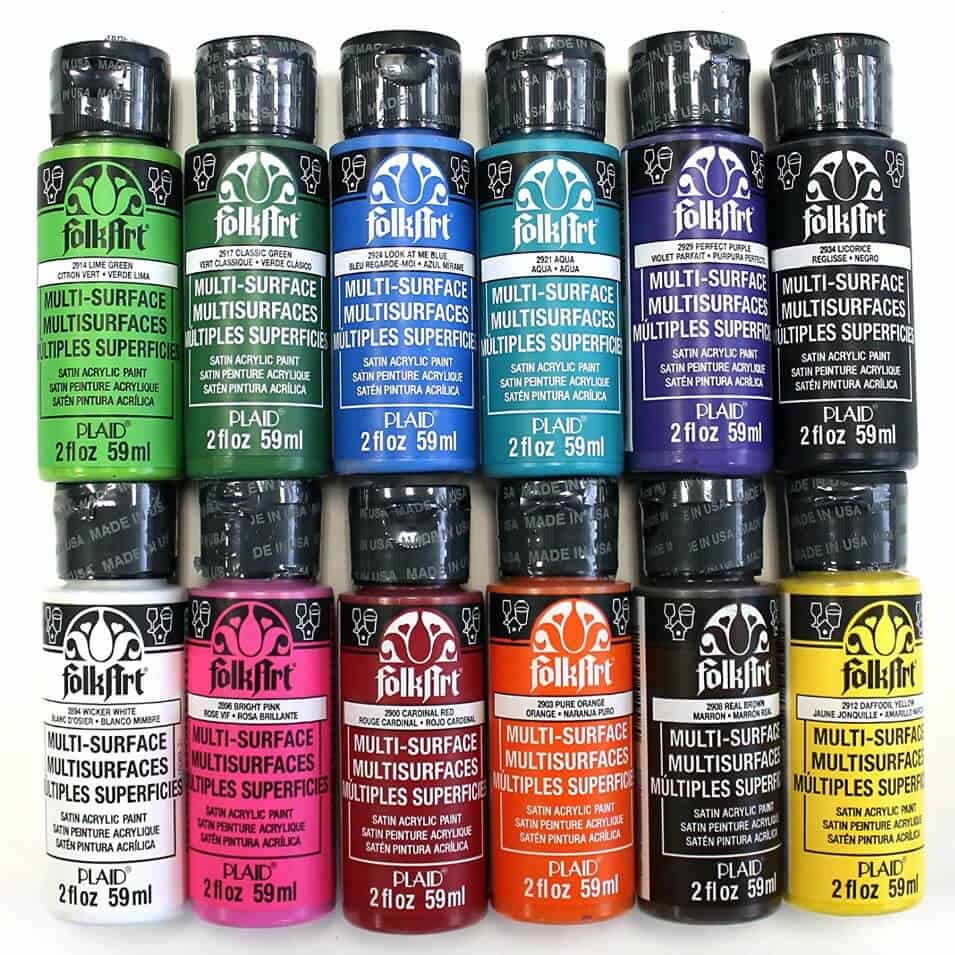
Acrylic Craft Paint
I’m thrilled to share my knowledge with you as a long-time user of acrylic craft paint. I paint nearly every Mod Podge project before the Podge goes on, and I use acrylic paint on projects that I don’t decoupage as well. If I can get away with using acrylic craft paint, even on a furniture re-do, I will. Why? Because:
- it’s easy to use – easy to brush and flows well, true to color
- it’s non-toxic and waterbase (typically made in the US; check the label)
- it’s inexpensive compared to oil-based paints
- clean up is simple – no solvents needed
Craft Painting Supplies You’ll Need
Craft painting isn’t hard – you can really just dive in. However, you will need some supplies. Here’s what I always have on hand (in addition to paint):
- Brush basin filled with water
- Paint tray (with a cover)
- Silicone mat
- Paper towels
- Paintbrushes – I address which kind in #3 below
This is what I use regularly, and I would say the only other thing you should make sure to have is a way to clean your brushes. You can use mild soap (like dish soap), but I really like brush cleaner.
Acrylic Paint on Wood
The most common question I get is about using acrylic craft paint on wood. First you should know that acrylic paint is made up of pigments suspended in an acrylic binding emulsion with a water base.
What does that mean?
That acrylic paints dry quickly, they are not toxic, and they can easily be cleaned with soap and water. That’s what I’m talking about! Here are the answers to some additional questions:
Can you use acrylic paint on wood?
Yes you can! The type of acrylic paint you’ll use depends on the type of project you’re doing. I typically use a higher end acrylic craft paint for my projects, even for furniture refinishing.
Do you need to prime wood before painting with acrylic paint?
You don’t have to, but I highly recommend it. Sand the surface and remove the dust with a tack cloth. I also like to put down a basecoat of white acrylic paint first as it typically leads to less layers of whatever color I’m using.
What is the drying time?
It depends on the conditions you’re painting in, but it’s usually dry to the touch at about 20 – 30 minutes, and fully cured in 6 – 12 hours. If it’s more humid, it will take longer.
How do you seal acrylic paint on wood?
You’ll use a clear sealer, like a polycrylic, to seal the paint on wood. I like to use Minwax Polycrylic Protective Finish to seal all of my projects. I apply with a nice paintbrush and let dry between coats.
What is the best acrylic paint?
For the crafts I do, I like FolkArt or paint. When I used to take art classes, I liked Winsor Newton as well as Liquitex. Those are great for art painting and canvas.
How to Use Craft Paint
I’ve been thinking long and hard about my most important tips on how to use acrylic paint, so that I could narrow it down for you.
Hopefully these crafting tips will help you, especially if you are making home decor, gifts, wall art, or any other projects that need to look fabulous (and flawless!). These are my top tips for how to use acrylic paint.

1. Choose the right type of paint and the right color.
Make sure you read the bottle carefully while you are in the store as opposed to just throwing it into your basket.
I know the acrylic craft paint aisle has a ton of selection, but you need to look carefully because it’s better than getting the wrong thing and making multiple trips.
You should look at the bottom of a bottle of paint to tell what the color is, rather than the label. While you are looking at the color through plastic, it’s more accurate than the label color because it’s the actual paint.
Remember that it’s going to dry just a touch darker than you see through the bottle – just a little. I match all my paint using the bottom of the bottom and never have a problem!
2. Prepare your surface thoroughly.
I’ve found that good surface preparation can make a project. Not preparing a surface can “break” a project. Here are the surfaces and what you should do:
- Wood – Sand smooth with fine grit sandpaper, wipe off sawdust.
- Glass – Thoroughly wash in warm, soapy water to remove dirt, dust and grease film. Then rinse in warm water and let it dry. (get our guide to painting glass)
- Canvas – Wipe primed canvas clean; if unprimed, apply 2 coats of gesso primer or acrylic paint.
- Plaster – Wipe clean with damp cloth.
- Plastic – Clean with soap and water. You will need a special plastic paint though – acrylic paint in bottles or tubes doesn’t stick to plastic very easily. I find the best way to paint on plastic is with spray paint made for plastic (then you can Mod Podge or use acrylic paint on top). (get tips for painting on plastic)
- Papier-Mâché – Wipe clean with slightly damp cloth to get rid of dust and let dry.
- Terra Cotta – Wipe clean with damp cloth to remove dust and let dry. (get our guide to pot decoration)
- Tin – Wash with soap and water, then wipe with a white vinegar dampened cloth if it’s really dirty.
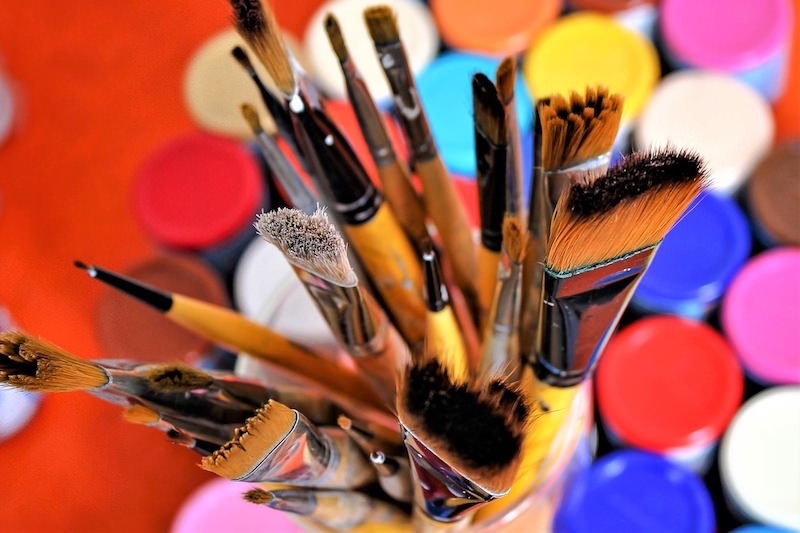
If you have a question about whether acrylic craft paint is going to work on your surface, do a small test in an inconspicuous area and let it dry. Try to scrap it off with a fingernail – you’ll be able to tell if it’s going to work or if the paint is going to scrape right off very easily.
3. Use good quality brushes and take care of them.
It’s important to me to use soft natural bristle or taklon brushes (I love these brush sets – or these).
A crappy brush will show brushstrokes or leave brush hairs in your project. I have wanted to throw a project across the room because I couldn’t get a brush hair out of it – they are very elusive! Invest in your brushes and they will invest in you!
Wash your brushes between projects and leave them to dry on a paper towel (use your fingers to shape them while they are wet). Well cared for brushes are worth the investment because they will last a long time. The same goes for rollers or sprayers. Don’t scrimp and clean them up thoroughly afterwards.
4. Don’t put too much paint on your brush.
Paint should only be from the middle of your brush hairs up towards the tip. You do not load the entire brush up to the metal part (know as the ferrule). It’s better to go back and get more paint than to have too much.
Too much paint can make the brush go wacky when you press it down and make the paint harder to apply (especially important for detail work). If you need to cover a bigger surface, get a larger brush or use a roller.
I’m telling you that I don’t have patience – but I never load my brush with too much paint. Patience is a virtue in this situation, trust me.

5. Consider priming, and definitely basecoat dark items with white.
If you don’t prime, you can possibly spend a lot longer covering an item, and you may not get the adherence of paint or the brightness of color that you are looking for.
This is especially true if the item is dark. I’ve painted 20 coats of a lighter color over black and didn’t even have 100% coverage.
I recommend using gesso or a highly pigmented white (like FolkArt Titanium White) for priming. Kilz is also great if you need a large amount of primer or a product that acts oil-based.
6. Keep water nearby so that you can add it to your brush frequently.
Acrylic paint, when put on a palette, tends to dry out somewhat quickly. It’s not THAT quickly, but it’s enough that the paint could start drying while you are painting an item.
Don’t thin out the paint too much because you’ll dull the color, but it’s okay to dip your brush into water in a basin and swirl it around into the paint to get it going again.
I typically pull my brush out of the water basin, press lightly to a paper towel, then add paint. By pressing my brush into a paper towel, I’m removing some of the water . . . but not all. This helps me in the summer especially when (because of the area I live in) my paint dries quickly.
7. Use a sealer to finish.
Acrylic paint has a somewhat chalky feel (well, depending on the finish) without a sealer applied. Some acrylic paints are Satin or Gloss and have a built-sealer, so then you won’t have to add anything on top.
If there is no built-in finish, I would use a clear acrylic spray or brush on sealer so that the surface doesn’t scratch easily. It’s not required, but it’s helpful to make your project last longer.

8. Make paint chips.
Use cardstock to create “chips,” or small squares that show the colors you have in your stash. That way you know what you have for the next project.
They’re very easy to put together; simply cut cardstock into 1″ squares and paint a little bit in the middle, then let dry. There’s your sample!
Now you can take the chips to the store for home decor matching . . . rather than hoofing the table you painted to the fabric store to get coordinating curtains!
Now that you have a better grasp of how to use acrylic paint, I want to tell you about my favorite brand – I recommend FolkArt paint! I’ve using it for years. What do I love about it? Many things! It’s the best paint for wood crafts:
- Amazing color palettes
- Comes in many types (Enamels for glass, Fabric, Outdoor, etc)
- Creamy consistency and good coverage
- Durable finish
- Water based, matte finish
- Made in the USA
I know I sound like an infomercial, but this isn’t sponsored – I just really love this paint. I’ve tested a lot of different kinds and it’s easiest to work with by far.
Want to try your hand at a project – maybe you’re new to using acrylic craft paint? Check out three fun techniques to make canvases! Simply press “PLAY” in the center of the video in this post!
If you enjoyed this article on acrylic craft paint, here are some others that you might enjoy:
- Color Shift Paint: The Ultimate Guide (Plus Projects!)
- Easy Rock Painting Ideas for Kindness Rocks Project
- 101 Unique & Amazing Mod Podge Uses!
- Genius Crafting Tips (You’ll Use Again and Again!)
- DIY Sticker Remover: 10+ Non-Toxic Methods
- Easy Painted Rocks That Are Fun to Make & Tips!

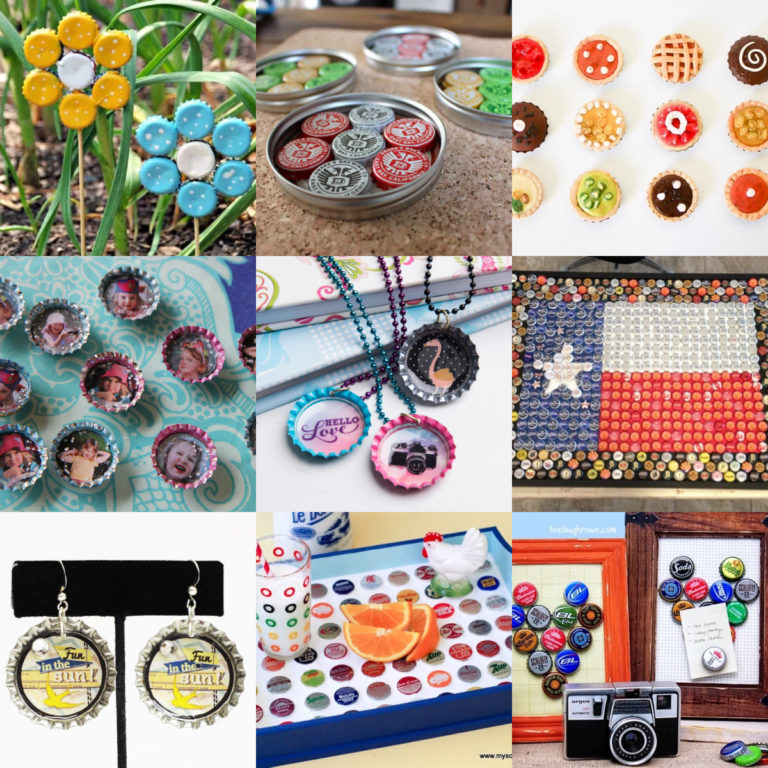
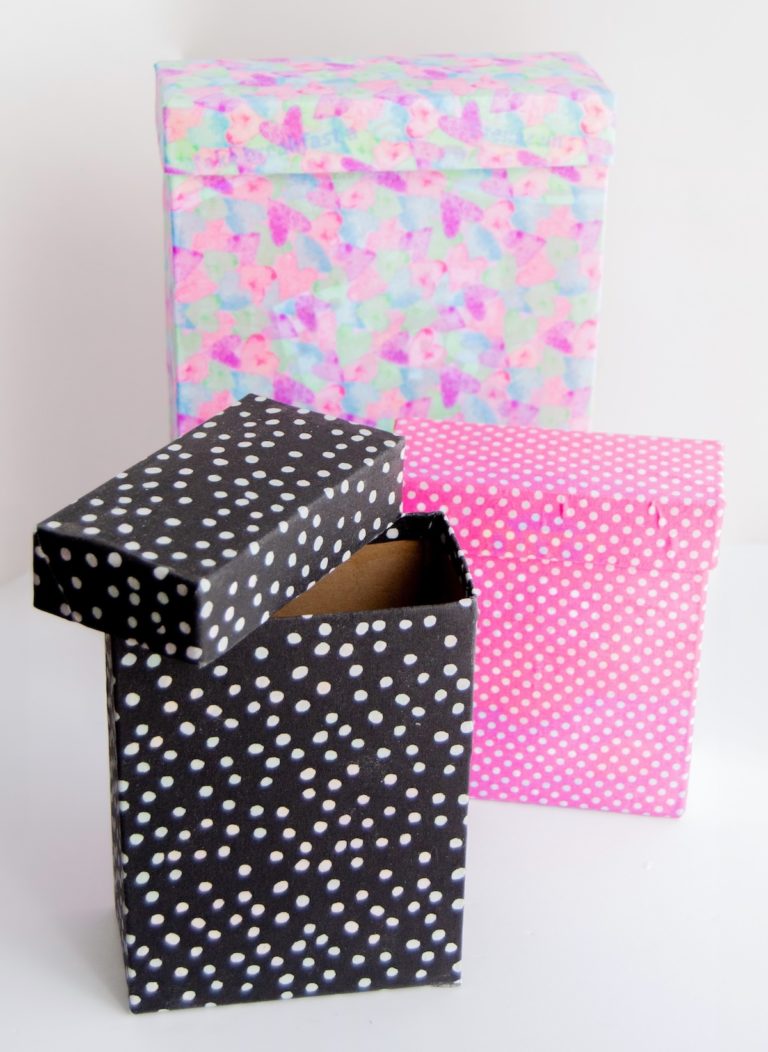
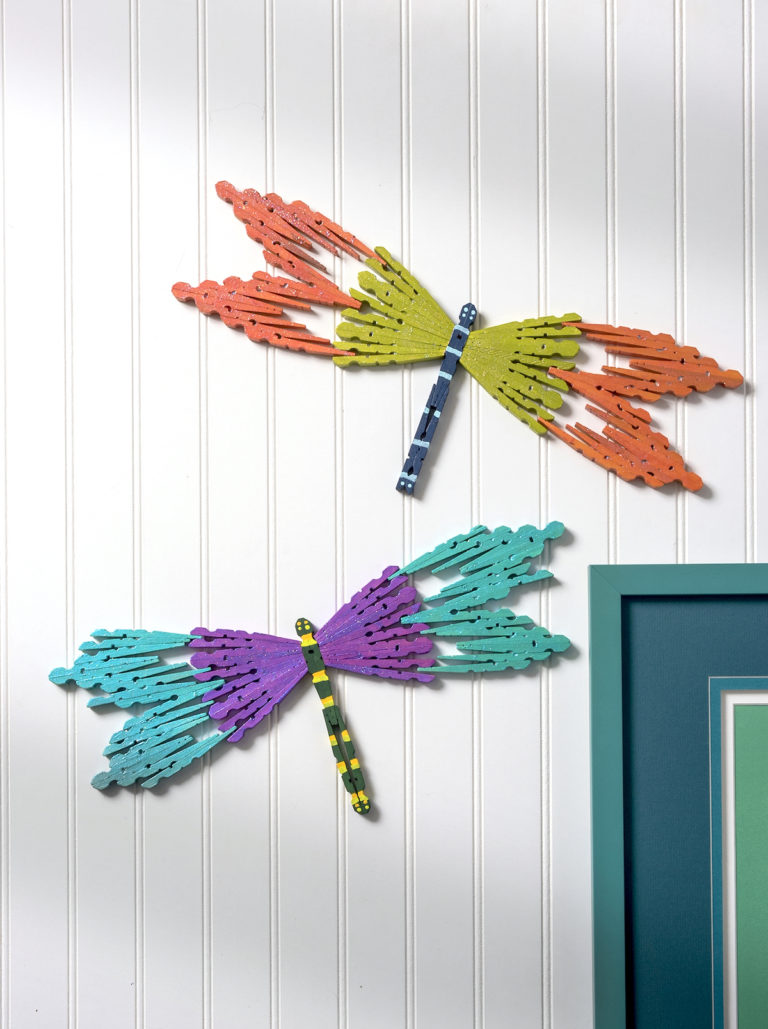


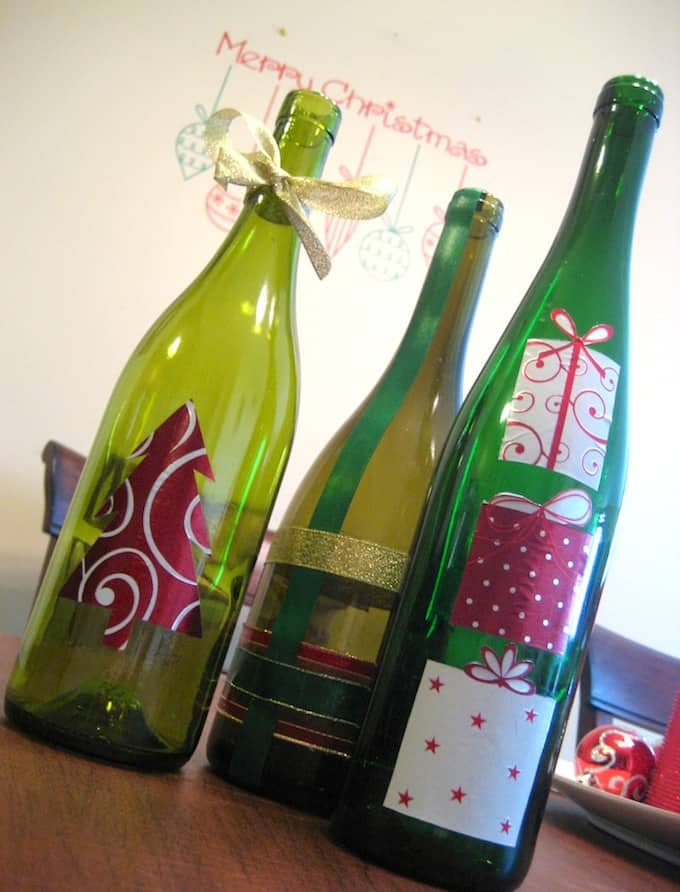
Great tips. Thanks.
Thanks for the really useful tips for paint!! I know all these are really good,I am just bad in cleaning my paint brushes,,because I am tired & Lazy mostly!! Huh
Thank you for the great tips…I use this stuff pretty often too!
I want to thank you for this article – it’s very helpful! Acrylic paints are the only paints I use in my craft, so it’s good to know these things….thanks again! 🙂
great tips, Amy. I’ll definitely bookmark this page for my readers too!
One other thing I do to for brushes – I leave a little soap in the brush after cleaning, then shape with my fingers and allow to dry. The soap ‘holds’ a nice shape and brushes last a lot longer 🙂
I foumd this through Pinterest. Great ideas. I love your blog 🙂
http://barnyardchic.blogspot.com/
If you want to paint on plastic , what paint would you suggest ? I know they used to make a paint for plastic but has been discountinued . What would you use instead ?
Wonderful! Just in time for a DIY project of mine.
I can’t tell you how badly I needed this post. I aspire, someday, to suck considerably less at painting!
These are some good tips. I usually take a bit of the paint and coat the top of the cap for my paint swatch. It makes my colors easier to find too since I store them upright in a basket.
Thanks for the tips, sometimes acrylic paints can be a little tricky.
A jewelry blog.
Awesome article. I found it on Pinterest.
😉 xoxox
great tips! one I do is store my bottles upside down. Doing this allows you to see the color and it keeps the top from becoming clogged with dry paint.
Works well for me!
I put a dot of paint on the lid of each new bottle after its first use and keep them all in a shallow, lidded plastic bin. I can just open it up and see all the lovely shades!
Thanks for the great tips! I’ve been painting with acrylics for several years naow and have a couple other tips that I’ve used and a possible solution for the painting on plastic issue.
First, I came across this tip years ago for and use it especially for an older bottle of paint that may have been sitting around for a while. Cut a small piece of nylons or panty hose, remove the cap from the bottle and stretch the material over the opening, then screw the cap back on over it. This will help filter out any blobs of paint that may have accumulated while sitting.
Second, for painting on plastic, I have basically “primed” my surface with some of the “Fusion” for plastic spray paint. Just be sure to use a matte or flat color. Then I painted directly over it with my acrylics. I did this on some plastic flower pots over ten years ago and they are still looking great. I didn’t even bother to seal them and they have been outside ever since.
Is it possible to paint a canvas with acrylic paint and use mod podge matte to seal it or would i have to get the spray paint to seal it?
Hi Anonymous! You can definitely do what you are suggesting. Good luck!
Any tips for painting a light color over a dark color? I just put sealer (Triple Thick) over a canvas painting and anywhere I had painted a light color over a dark color the dark color bled through. Thanks!
Hi Lindsay, What kind of paint are you using? Typically if the dark paint below is dry with acrylic, you should be able to paint on top with no problem.
Thanks, Amy! I was using acrylic and I did let it dry. Oh well…I’ll keep experimenting! Maybe I should try sealing with Mod Podge 🙂
Very useful tips….ill try to care for my brushes better in between projects because i already ruined one :(, but thanks for the tips i use acrylics to paint my wooden jewelry!
i am about to embark on making a shabby chic wooden heart garland for my home, I would like to know whether i will still need a primer for the hearts, they are bought already cut – i will be painting them white and red.
thank you –
Karen, for something so small you don’t need to prep. Even if you have to paint several coats, it won’t take you long – so you COULD prep, but you don’t have to.
I used these paints when doing my teracotta pots. My granddaughters started with me at age 3, rather than any other paints, we use acrylics. And I use FINGERS, a child’s finger is perfect for flowers, etc. Pansies are beautiful. Taught the 9 yr old how to ‘clean the brush’ making puff flowers. We take the 4 inch terra pots, paint as a theme and add a Goodwill bought animal that matches paint. Donate to Relay for Life. Everyone wants something painted by a child! I seal all pots with any good brand of clear spray paint. Several layers when using for real plants on the steps. Every couple years reseal.
Can you mix acrylic paint with mod podge to create a colored glaze effect? I am thinking gold or silver paint… Also, have you ever mixed glitter with acrylic paint? Thanks!
Hi Dana! Yes you can definitely do that! and I haven’t mixed glitter with acrylic paint, but you’d probably have issues because the acrylic paint is opaque so it would cover up the glitter. But it’s worth trying!!
Hi Amy. I am starting to do my arts and crafts thing again. I was a girl scout troop leader for 7 years (in charge of “creativity”) many years ago. And while I swore off glitter and actually cringe at the very sight of it (;-), I never stopped “creating” things for myself. I am now venturing into the wonderful world of scrap booking and found tiny unfinished wood pieces like stars and clothespins. I am so glad I found you! Your tips are great as I have to paint these little treasures. My question: how can I paint them being they’re so small (1/2 – 3/4 inches) without messing them up! Can I dip them using tweezers? How can I dry them w/o screwing it up!? Help! Thanks for your help and a great site.
HI, I want to use acrylic paint to paint over a factory printed canvas then I am going to modpodge top it with a design from scrapbook paper and modpodge on top of the whole thing to seal it in good..my question is, can i just paint right over the print or to I need to primer it first?
Hi! It depends on how dark the print is. You can use paint, but primer might cover it faster if it’s dark – because primer has more pigment in it 😀
thank you
I painted a beer mug with acrylics and was wondering if i could put a coat of modge podge gloss over it to seal and make it shiny?
Hi Anonymous! If you are wanting to drink out of it (and wash it), you’ll need to use Enamel paints and no Mod Podge. If it’s just decorative, the acrylic is fine, and you can use Mod Podge to make it glossy 😀
Thanks for the tips. I’ve only got in contact with my ‘inner crafty’ the last couple of years! It has been a journey. My FYI is, I paint plastic pots with acrylic paint. Yep. I sand them first (I saw this online), with sand paper from Dollar General, then spray a clear,plastic primer and let dry.
I tried to paint a design on a wooden stool that had been spray painted with a satin finish acrylic. The craft paint didn’t give good coverage…and easily peels off like skin. Do I have to sand it down to bare wood and start over? Any suggestions? I really, really, want this project to work!
Hi Pam! Yes, there must have been something in the satin finish acrylic – not sure what paint was used, but yes, you’ll need to sand down. Not to bare wood, but to at least rough up the surface!
Thanks Amy, a little bit of sanding worked!
I found your blog through google trying to think of a way to “re-color” my heels. I don’t know why I purchased a pair of pink heels. It’s not really my style — maybe I got inspired from looking at someone’s fashion post and thought I could pull it off. I don’t know much about arts & crafts but I was wondering if you could help! My idea sounds like it’ll work in my head, but sometimes they don’t fall through like I planned. I was thinking to use acrylic paint, or some other type of paint, to re-color the leather on my heels black and then possibly using mod podge as a top coat. I don’t think it’s real leather or anything too special since the shoes were very inexpensive, $30 to be exact. I don’t want to leave them sitting in my room anymore collecting dust since they’re a very comfortable pair of shoes! Hopefully your crafty expertise can be of help! 🙂
It’s one of my favorite types of paint, because it is so versatile and can be used in many different ways to create many different styles of art.yes your tips are really great….
I am new at all of this type of crafting, but I have a project in mind and not sure how to proceed. I want to use a canvas and combine both scrapbooking paper and paint to design unique art work. In my mind, I mod podge the paper in place and then after that dries, paint designs, patterns, etc. around and across the canvas.
Does this sound correct? And if so, is the acrylic paint (Apple barrel, etc) the type paint I should use. If not what kind should I use.
Thanks for the in put!
Hi there! Yes, this would work – You can paint over Mod Podge when it’s completely dry. Acrylic paint will work (Apple Barrel, FolkArt, etc.). How fun!
I am wanting to decoupage a decorators table that I have and use it as a side table. The top is made of plywood. Do you recommend the acrylic pain to the surface first. I plan on using old wallpaper the size of the top of the table as a backdrop and then putting bright color paper flowers over the wallpaper. Just wanted your thoughts as to which way to go. Thanks
Hi Natalie! You don’t HAVE to use paint over plywood – but I always do. If you don’t, sand lightly and wipe away the dust. You don’t want there to be any coating and you want the surface to be smooth and clean.
Hi! I painted a plywood sign with acrylic paint, and I was wondering if I could use a clear polyurethane sealant over it, or if that would ruin it.
Thanks!
Hi Rachel! No, it will not ruin it. You should be fine 😀
Okay, thanks! 🙂
Is it ok to add water to bottles of acrylic paint that is REALLY thick?
Hi Deb! Yes, I would 😀
I’m decorating an old metal teapot using decoupage and acrylic craft paint. Can I thicken up the paint with mod podge so it adheres better and needs fewer coats?
Hi Catherine! You can use primer to do that – Mod Podge isn’t intended to be a paint thickener, and because it’s clear it won’t cover better.
Thank you, Amy!
Sorry to bug you again, but what kind or brand of primer should I look for? Thanks in advance!
Hi, was wondering why the acrylic paints (indoor/outdoor)8oz. Bottles become thinner in consistency over time? Why not thicker? Thank-you
Hi Tami – that is odd – I’m not sure. Are they separating? Are they acrylic?
I have a pair of metal earrings that are painted from Wal-Mart. The paint has come off of them so I am taking them back. I want to get a new pair and was wondering if I put Mod Podge on them before I wear them, will it keep the paint from coming off? Thanks for your help.
Hi Pamela! You could try it! Or you could try regular clear spray sealer, too 😀
I want to thank you for this article – it’s very helpful! I am a big fan of your blog. I recently have started painting canvas shoes with acrylic paint . But i want to fix the paint, is it ok if I top coat with modpodge and which one of them would u suggest? Also if there is any other thing to fix the paint which I can find in India?? please let me know . It would be great help. Thank you
Hi Akanksha! I would use the outdoor Mod Podge on shoes – in multiple thin layers. Unfortunately I’m not quite sure what’s available in India that would also work!
Thank you so much !!!
I have painted a canvas with acrylic paint, but I want to put photo prints on the canvas (on top of the paint). What is the best way to get it to stick? Thanks!!
If they are “regular” photos with a slick back, then a strong spray adhesive would work best. Otherwise, Mod Podge!
Hi Amy! Your tips are very useful!
I have two little question (about vinyl material), I hope you can help me 🙂
Exactly, how does gesso primer work? Do I have to mix it with water and then use it with a brush, like common paints? I ask you this because I’m worried applying it on a rounded vinyl surface will cause little cracks.
And, I’ve always heard sealer has to go under the paint, do you think putting it over could give problems? Maybe is there something else I could use to protect a painted vinyl object and prevent it from scratching?
Thank you!
Hi Leila! Gesso primer works by itself – no water required. BUT I’m concerned about putting it on vinyl. Vinyl and acrylic based products typically don’t mix. I’m not quite sure what to do except use a plastic primer and then paint over it . . .
I need some help and can’t seem to find an answer anywhere. i have a wooden shape. on the wooden shape i painted a layer of acrylic paint (pink) with no problems. i then placed cut out words made out of contact paper over that. I then painted a layer of white acrylic paint over that. Then, I painted another layer of acrylic paint (brown) over that. When i took off the contact paper to reveal the letters (pink) the brown peeled right off of the white. I’m not sure why it’s doing that or that i can do to fix it :\
any suggestions?
Hi Rebecca – did you let the paint dry thoroughly between layers and before putting the contact paper down? Also what type of acrylic paint was it?
I did let everything dry. I’m not having a problem with the paint under the contact paper coming up it’s the top layer of brown paint that is peeling off the middle layer of white paint. My white paint is “My Studio” by a.c. moore and my brown is also “My Studio” by a.c.moore.
I came to the conclusion that it was the white paint. I had painted 3 different projects throughout the weekend with the white below another layer of paint and on all three projects the top coat of the other color peeled right off! I have pictures of all the lovely peeling paint. Needless to say, i won’t be buying ac moore brand acrylic paint….
Hi Amy!
For about 7 years now I have been aimlessly trying to teach myself how to paint with so~so results. Anyway your guide is perfection, I can’t wait to put these new ideas to work!
Quick question is there a way to make your own easel?
Hi Kalan! Glad you like it! Honestly I have no idea how to make an easel – I would Google it. Sorry I wish I could help you!
Can you give a suggestion of a type of sealer to use on top of acrylic over an unfinished (sanded) wood toy building? The project looks good but definitely has that chalky feel, and also I’d like it to be easier to wipe clean later. I think a paint-on vs. spray one would work best for this project but I’m not sure which kind would be best, I’ve used some bad sealants before that yellowed or distorted the color, or didn’t have a good feel themselves :(.
Hi there! Yes, most people I know like Minwax Polycrylic. Agreed about the brush on. Have you tried that one?
Hi! I used acrylic paint on a canvas and I am going to mod podge pictures and cardstock letters onto it. (Think 20×20 birth announcement for my bedroom wall!) I just finished painting it and it’s drying. Do I need to spray it with a sealer (Mod Podge brand, of course!) before I Mod Podge the pictures and letters, or can I just Mod Podge away? My fear is that the paint is going to smear the colors, because I’ve painted the canvas 2 different colors. Thanks!
I have Mod Podged on acrylic paints many times with no problems! Having said that, I would always do a test in a corner of your canvas 😀
Thanks!
It turned out great!!!
Maybe you can give me a suggestion. I’m redecorating my library and want to make people size paintings of book characters. I’m planning to paint the character on white butcher type paper then use concrete block adhesive to stick it to the wall. Could I then mod podge over the whole thing to give it a more finished look? Any advice would help 🙂
Hi there! You could try it – I don’t know anything about concrete block adhesive so I can’t be sure that they will interact okay. I would try a test first! But you can definitely Mod Podge things to the wall just fine 😀
Hi I googled painting with acrylics on unfinished wood and found you!!! Yay!!!
If I am understanding all the messages before I can find acrylics for exterior uses? I should prime first? I have kilz. I also can seal with water based polyurethane?
I have my grandchildren coming for a visit and I bought unfinished birdhouses for us to paint. I thought it might be a nice memento of time with grandma.
I obviously would like them to last as long as possible. Thanks for your help.
Hi Sherrie! For painting the birdhouses, I would use FolkArt Outdoor. THEN I’d also put a poly coating on the outside. You don’t need to prime first UNLESS you live in a really wet area – like the northwest. Have fun!
Hi, I really enjoy reading all of this great information. I had a question about some necklace pendants that I am making using unfinished wood. I am painting them with acrylic (not with built in sealer) and then using a glaze (diamond glaze) to give the top a glossy shine. I was wondering if I should use a sealer before I apply the glaze? Thank you for any suggestions you may have.
Hi Kristi! I don’t think you’ll need to use a sealer, but I would do a small test just to be sure!
not sure if you can help, but here it goes, I painted a small wood truck, spent at least 15 hours of very detailed painting, then use polyuathane (?) and now the pale pink only after 3 days has crazy yellow striks…don’t really know what to do…HELP, Please
Hi Melinda! Unfortunately I don’t know enough about your project to help you. It really depends on the paint you used and the sealer. 🙁
Thanks for the info. I have recently painted some wine glasses with plain acrylic colours and was wondering if I should use a clear spray to seal it? I have read baking helps but dont want to take chances that my paint burns in the oven! Any advice is appreciated. Thanks.
Hi Chandra! Are you going to be drinking out of them? You will not be able to wash them unless the paint is enamel/made for glass. If they are just for display, using a clear spray sealer is just fine.
I had thought of using them for drinking – but I realized a bit too late that acrylic is not the right type! Thanks I shall clear spray them.
So I can use acrylic paints on glass if I dont plan on washing or wiping the glass afterwards ? and should I seal my paintings after im all done with some sort of sealer spray ?
Hi Kara! There are special formulas just for glass if you would like them to be washable (for example, FolkArt Enamels). If you aren’t going to wash the plate, then yes, you could use regular acrylics and just spray seal.
Hi Amy, Great name by the way:-D!!
I bought a great apothecary jar that’s clear glass with a plackard on the outside that says “Treats” & want to paint it to be used for dog treats (Honey Nut Cheerios! Our vet recommended them because they’re wayyy healthier & not fatt-
ening & our pups LOVE them). I see that I need to use enamel rather than acrylic, but is it ok for me to paint the inside of the jar as I had planned? And do I need to seal it? If so, what product do you recommend? Thanks so much!
Hi Amy! I recommend using glass paint (you can still use an acrylic like FolkArt Enamel) but you should put it on the outside. Technically acrylic paint is not food safe. You wouldn’t need to seal it.
Hi, I use water based non-toxic acrylic paint and seal with non-toxic mod podge sealer that drys with a shine. I want to try the matte finish sealer and picked up a small bottle (the big craft store only had the large shiny mod podge, found the matte finish at a much smaller store) i don’t like the lines it leaves. I am using a small paint brush to apply the sealer, should I use something else? everything has to remain NON-TOXIC so this is pretty much what i have to work with unless you have better options? Should I try mixing in the sealer with my pain BEFORE i paint? or continue to paint then seal? any advice would be helpful. thank you !!!!
Hi Jeanette! This is from my FAQ: https://modpodgerocksblog.com/learn-how-to-mod-podge/
How can I minimize/eliminate brush strokes?
Use a soft bristled brush and then sand between coats. To do this, apply the Mod Podge and let it dry an hour. Then use #0000 steel wood and lightly sand the entire surface. Do this between every coat. After the final coat, sand and then spray a clear acrylic sealer to finish.
Thank you for your reply. I have not found a NON-TOXIC sealer spray. Its critical everything I use be NON-TOXIC, is there one? I will be thoroughly reading through your entire site as soon as I can!! thank you….
The brush on sealers are non-toxic – the sprays all have propellant in them. They are *mostly* non-toxic 😀
Re: Minwax Polycrylic Protective Finish… does this dry clear and not “matte”(which to my eye mutes vibrancy) or “semi-gloss / gloss”? I spent a lot of time on my paintings of acrylic on wood and I haven’t sealed any of them because I’m scared it might affect the painting that I pained over. Yet I can’t really share or sell my work until I can proceed properly. Advice?
Hi John! You are able to buy it in multiple finishes. So my advice is to go to the hardware store/Home Depot and find the gloss finish that works for you – and yes, it dries clear!
Hi Amy,
Thank you for sharing.
I got the satin type and just used for a couple of jewelry projects.
The bottle says to cure the surface after painting.
I’ve used it on metal (brass, bronze) and tin.
Not sure I want to bake the tin, since it has a painted pattern.
Do you have experience?
(You mentioned tin in the post above.)
Thank you! 🙏
Milena
Hi Milena! You don’t have to bake it. You can just let it dry naturally and it should be fully cured in about four weeks. That doesn’t mean you can’t use it since dried is different from cured 🙂
I have beautiful pieces of wood, that I want to paint scenes for the holidays, I would like to keep the real wood as a back ground showing the grain, is there a clear primer that I can paint over then seal when completed
Hi Sheryl! You can use a clear spray sealer (acrylic) or a brush on to seal your scenes. You don’t need Mod Podge if you aren’t decoupaging, though if you have it you could use it to seal!
AMY HELP PLEASE, I read somewhere on your page you raved about Folk Art Color Shift paint. The bottle does not give surface info. I google searched it said it can be used on glass, not working for me. Should I use gesso or use black glass paint before using the Color Shift? Thank you,
Hi Ann! First make sure you prepped according to instructions here: https://modpodgerocksblog.com/color-shift-paint/
If it’s still not working, you can definitely gesso first or use a glass paint. Sometimes, depending on the glass (quality, etc), people have to do that with Mod Podge as well.
I find that if I use distilled water with my craft paint the colors flow much better, I have used distilled water in other applications around the house and it is amazing.
That’s a great tip!!
This helped me a lot thank you
I’m new to all of the paints
Retired and trying my creative energy on making wind chimes with my wine bottles and have some wood projects also. So thanks a lot for this Jan
My pleasure Jan!
Hi, I’m making u of m letters . On a block top of course is maze and the bottom is brown. It’s hard to get between the curves. Is there a way I can dip them into the paint if so can you please tell me the best way to do so…
Hi there Kaye! I’d personally just use a different tool. A smaller brush, a Qtip, or a piece of sponge! To get in the curves anyway 😀 I don’t think I’d dip anything. That would probably just end up being a mess and I’m not quite sure how you would do it.
Hi! absolutely lovely tips, but I have a question. I have these wooden letters that I painted with acrylic and I’m planning on sealing them. Should a lightly sand them between or after sealer coats? (I did not sand the wood before putting the paint on)
Hi Ece! I don’t normally sand but some people do that want a very, very smooth finish. If I were re-doing a piece of furniture I would sand. For a wooden letter, I wouldn’t personally.
above else I use primer first.
What kind of primer is best for wood? Like if I was going to the store in crafts section, what do I look for? Is it primer (grey?), white base, final color paint? Is that how you suggest?
When I “prime” something on unfinished wood, I just use white acrylic paint. When I prime something on a surface that is already painted, I use something a little bit more intense that will provide coverage like Killz.
I am making waste paper basket and clothes hamper for the bathroom. It will be made from cardboard and newspaper. What is the best black out paint and sealer? I am going to paint the items black. Should a use a black out paint?
Hi Delores! I’m not sure what black out paint is – I would use an outdoor craft paint in black simply because bathrooms are usually moist, at least for part of the time.
Help! I am a new 4th grade teacher this fall & I have painted an old rocking chair with semi gloss white paint I was wondering if I could use acrylic paint to put some decor/details/lettering on it? If so what kind of acrylic paint would adhere to it??? And would I need to seal it?? Thanks so much! I have been looking all over the Internet and I can NOT find specifics for doing “details like letters” on semi gloss painted furniture😩
Hi Maddy! Honestly I would give it a try with multisurface paint. Which is the same thing as acrylic craft paint, it’s just made for multiple surfaces. You would see a few brands (Apple Barrel, FolkArt) at the craft store that say multi surface. Honestly I would do a little test. Put a dot in a non conspicuous place and see if you can easily scratch it off when dry. If so . . you might need to put a sealer on top of it. Like a spray sealer that works with semi gloss paint. That’s my only concern is that I’m worried the gloss of the paint might not fully take the acrylic paint. But sealing over the top would be fine. It’s just a matter of making sure everything works together by doing a test!
Hi Amy, I am painting foam clay using mostly Apple Barrel acrylic paints. I have noticed the antique
white ends up showing crack lines in it after it dries. I haven’t been using a primer; instead just paint the object then apply Mod Podge. I don’t notice this when using other colors. Any advice? Thank you~
Hi Zema! I’m wondering if the paint is not dry underneath. You can crackle with Mod Podge like this when wet: https://www.youtube.com/watch?v=IvxC-GGw7RA
If it only happens with white, the white might take a bit longer to dry? And also depending on the color of paint there are slightly different things in it. So I’d try to let it dry longer and see what happens.
I love doing crafts and use acrylic paints always.I have a mermaid statue outside and her hair is brown without mixing colors together I want her to look blonde and not real yellow what color could you suggest to me to use.
Hi Dolores! It’s hard to know what kind of yellow you are looking for but there is a catalog – https://plaidonline.com/catalogs/folkart
Take a peek and see what color works best!
I am making the lanterns with the hot wheel race tracks. I already sanded them and they are ready .my tray is made out of wood. I am 79 and what type of primer should I use. I am going to paint all of the lanterns with Apple Barrel acrylic paint. Can’t afford chalk paint. I am going to paint them by hand.I will spray on the primer.
Hi Dolores! You can use a white craft paint to prime. And you can paint on by hand. Or, go to the craft store and get a spray primer. But if you are being cost conscious, just go ahead and use craft paint as a base. FolkArt Titanium White is amazing coverage.
I have a metal model that I bought that was already painted dark red, probably sealed. I want to change that color to a lighter burgundy. The interior is black, seems to be plastic. I would like to change that color to a yellow, ostrich like color.
So, should I sand the red, prime it, both, or just paint it.
What about the plastic parts? Same questions
Hello! Model building is not my area of expertise but I would look at these paints: https://www.amazon.com/Model-Paints-Plastic-Models/s?k=Model+Paints+for+Plastic+Models
If it’s me and I want to lighten, I would sand. But I don’t know much about it!
Great ideas for paint. I do have one question. Can I use the paint on cardboard boxes?
Hi Louise! Yes you can. 🙂